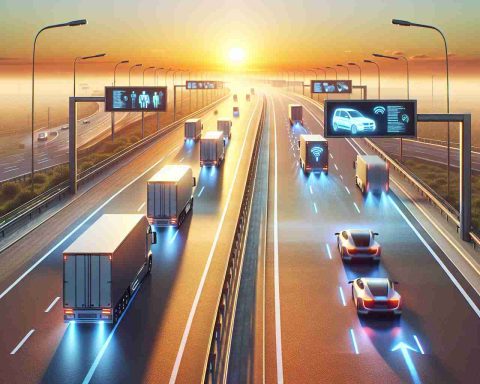- Autonomous trucking is nearing a breakthrough, with technology ready but commercialization as the next hurdle.
- Torc Robotics and others highlight the importance of safety and resilience in driverless trucks, crucial for highway conditions.
- Industry leaders show optimism for autonomous milestones, but challenges around cost, operations, and maintenance remain significant concerns.
- Autonomous yard trucks may lead the charge due to their suitability for structured environments, potentially speeding up broader adoption.
- The acquisition of Trimble’s telematics by Platform Science signifies a move toward integrated solutions, enabling better vehicle technology integration.
- The road to widespread driverless truck adoption requires patience and strategic adaptation to ongoing developments.
The desert city of Las Vegas, with its neon-lit skyline and perpetual motion, served as the backdrop for a transformative moment in the world of transportation. The Manifest conference gathered visionary minds leading the charge toward a future where trucks traverse highways without drivers, suggesting a robot-tinted tomorrow for logistics.
Autonomous trucking, long whispered about in industry circles, is now shifting gears with companies eager to showcase their strides. Giants like Torc Robotics rubbed shoulders with nimble newcomers like Bot Auto. Their unified chorus? The technology is ready; it’s commercialization that poses the next hurdle. Torc Robotics, bursting with innovation, boasts trucks equipped to soldier on even in the case of partial system failures, underscoring the steep safety demands unique to highway leviathans. Such resilience isn’t just an advantage—it’s imperative when hurtling down interstates at breakneck speeds.
Industry insiders, like Covenant Logistics, remain cautiously optimistic. Encouraging breakthroughs in driverless milestones are encouraging for truckload companies eyeing these developments with growing interest. But skepticism lingers. Questions about cost, operational lanes, and maintenance loom large, casting shadows over the sunlit path to adoption.
In a twist, autonomous yard and terminal trucks might accelerate the shift. With their operations tailored for structured environments like drayage yards, they present a compelling case for quicker implementation, heralding an incremental evolution towards driverless highways.
As Platform Science completes its acquisition of Trimble’s telematics, the stage is set for a future teeming with integrated solutions, where Virtual Vehicle tech harmonizes disparate applications under one digital roof.
The underlying message resonates: autonomous trucking is rumbling at the gate, poised to alter the roadways. Yet, the journey demands patience, tenacity, and a keen eye on evolving complexities. Will driverless trucks become road royalty or remain in a beta state? Only time will tell.
How Autonomous Trucks Are Set to Revolutionize Transportation
How-To Steps & Life Hacks: Implementing Autonomous Trucking
Transitioning to autonomous trucking involves key steps to ensure a smooth integration and operation:
1. Assessment of Current Infrastructure: Evaluate existing logistical operations and infrastructure to determine readiness for autonomous vehicles. Identify areas that require upgrades or changes to accommodate new technology.
2. Partnerships with Technology Providers: Establish collaborations with leading companies in autonomous technology, such as Torc Robotics or Bot Auto, to gain access to cutting-edge innovations and support.
3. Training Programs for Workforce: Implement training for existing staff to manage hybrid operations, including the use of autonomous systems and monitoring the vehicles’ status.
4. Regulatory Compliance and Safety Protocols: Ensure adherence to government regulations and industry safety standards. Participate in pilot programs to gain practical insights and supportive regulatory approval.
5. Phased Implementation: Begin with controlled environments, such as autonomous yard trucks in terminals, before scaling up to highway applications. This strategy provides crucial data and helps in adjusting processes incrementally.
Real-World Use Cases
– Long-Haul Transport: Autonomous trucks can revolutionize long-distance freight transport by reducing driver fatigue and potentially lowering costs.
– Port Terminals and Logistical Hubs: Autonomous yard trucks improve efficiency by conducting repetitive tasks in controlled environments, enhancing throughput at ports and logistical centers.
– Remote Areas with Limited Human Resources: Autonomous trucks can serve regions lacking sufficient human drivers, ensuring consistent delivery services.
Market Forecasts & Industry Trends
The autonomous trucking market is expected to grow significantly, with some projections suggesting market volumes reaching over $1 billion within the next five years. The advancement in AI technology, combined with increasing demands for freight efficiency, will drive this growth.
Reviews & Comparisons
Torc Robotics vs. Bot Auto: Both companies present robust solutions, but differ in scale. Torc Robotics is known for its strategic partnerships, offering comprehensive integration, whereas Bot Auto is more agile, often providing cost-effective innovations suitable for smaller operations.
Controversies & Limitations
– Job Displacement Concerns: The rise of autonomous trucks raises questions about job security for drivers. Companies need to strategize on reskilling programs.
– Regulatory Hurdles: Different regions may have conflicting regulations, complicating cross-border operations.
Features, Specs & Pricing
– Partial System Failure Backup: Systems like those from Torc Robotics are designed to continue operation even when parts of the system fail, emphasizing reliability.
– Competitive Pricing Models: Autonomous trucking solutions vary widely in pricing, with larger fleets receiving potentially lower per-unit costs.
Security & Sustainability
– Cybersecurity: Protecting autonomous systems from hacking attempts is crucial. Companies are investing heavily in cybersecurity measures.
– Environmental Impact: Autonomous vehicles optimize fuel use, potentially lowering emissions compared to human-driven trucks.
Insights & Predictions
The Future of Driverless Trucks: While full autonomy may still be years away, the increasing use of semi-autonomous features and technology integration points to a gradual path toward widespread adoption.
Tutorials & Compatibility
– Integrating Telematics: Companies like Platform Science are at the forefront of integrating telematics to create seamless connections between autonomous truck systems and management software.
Pros & Cons Overview
Pros: Increased efficiency, potential cost savings, reduced human error, and round-the-clock operation.
Cons: High initial investment, regulatory challenges, and potential job displacement issues.
Actionable Recommendations
– Start Small: Begin with autonomous solutions in closed environments to gather data and improve technology integration over time.
– Engage Stakeholders: Involve all stakeholders, from employees to regulators, early in the planning process to foster acceptance and support.
– Focus on Innovation: Stay informed about industry trends and invest in R&D to remain competitive.
For those interested in delving deeper into autonomous vehicle technology, platforms such as TORC Robotics and Platform Science provide valuable resources and insights.








